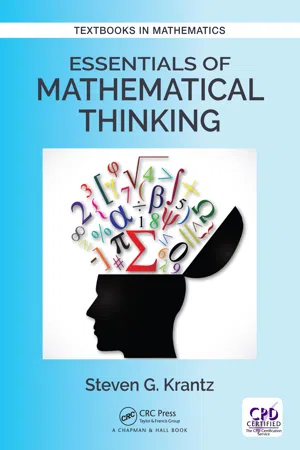![]()
Table of Contents
Preface
1 First Thoughts
1.1 What Is Mathematical Thinking?
1.2 How Does Mathematics Differ from Other Disciplines?
1.3 A Sample Problem
2 Diverse Mathematical Thoughts
2.1 A Fraction of the Time
2.2 How to Swindle on the Stock Market
2.3 The Bible Code
2.4 Winning on a Game Show
2.5 Cutting the Cake
2.6 A Lesson in Map Coloring
2.6.1 Analysis
2.6.2 Modern Developments
2.6.3 Denouement
2.7 The Complexity of Songs
2.8 Bertrand's Paradox
3 Strategy
3.1 It’s All in the Balance
3.2 See and Say
3.3 The Ponzi Scheme
3.4 Ham Sandwich Theorems
4 Focus
4.1 The Erdo˝s Number
4.2 Time Out
4.3 Days of the Week
5 Science
5.1 A Belt for the Earth
5.2 Your Next Breath
5.3 A Hairy Question
5.4 The Motions of the Planets
5.5 How Big Is Big Data?
6 Counting
6.1 Funny Numbers
6.2 The Pigeon Flew the Coop
6.3 Conditional Probability
6.4 Benford’s Law
6.5 Puzzling Birthdays
7 Games
7.1 How to Count
7.2 How to Beat the Lottery
7.3 The Eudaemonic Pie
7.4 A Dicey Bet
7.5 The Game of Life
7.6 The Tower of Hanoi
8 Geometry
8.1 Thoughts of Pythagoras
8.2 Symmetry
8.3 Buffon’s Needle Problem
8.4 Euler’s Formula
8.5 Sphere Packing
8.6 The Platonic Solids
8.7 Heron’s Problem
8.8 A Little Geometric Reasoning
9 Practical Matters
9.1 Strangers on a Plane
9.2 You’ve Got My Vote
9.2.1 The Plurality System
9.2.2 The Hare System
9.2.3 The Borda Count
9.2.4 Cumulative Voting
9.2.5 Approval Voting
9.2.6 Conclusions
9.3 Take Your Pill
9.4 Geometric Analysis and Facial Structure
9.4.1 Geometry and Facial Structure
9.4.2 Conformal Mapping
9.4.3 Wavelets and Filters
9.4.4 Summary Remarks
9.5 Beware the Raven
9.6 The Prisoner’s Dilemma
9.7 The Eyes Have It
9.8 A Sure Bet
9.9 Hilbert’s Hotel Infinity
10 Breaking the Code
10.1 Alan Turing and Cryptography
10.1.1 Background on Alan Turing
10.1.2 The Turing Machine
10.1.3 What Is Cryptography?
10.1.4 Encryption by Way of Affine Transformations
10.1.5 Digraph Transformations
10.2 RSA Encryption
10.2.1 Basics and Background
10.2.2 Preparation for RSA
10.2.3 Modular Arithmetic
10.2.4 Relatively Prime Integers
10.2.5 The RSA System Enunciated
10.2.6 The RSA Encryption System Explicated
11 Discrete Problems
11.1 Far-Reaching Dominoes
11.2 Surreal Life
11.3 A Problem with Marriage
11.4 Euler's Bridges
11.5 Scheduling Sporting Events
12 Advanced Ideas
12.1 Searching on Google
12.1.1 The Mathematics of a Google Search
12.1.2 The Directed Web Graph
12.1.3 Passage to the Web HyperLink Matrix
12.1.4 A Fix for Dangling Nodes
12.1.5 The Ultimate Google Matrix
12.2 A Needle Problem of Kakeya
12.3 Euclidean and Non‐Euclidean Geometry
12.4 Archimedes and the Calculation of the
12.4.1 The Genius of Archimedes
12.4.2 Archimedes’s Calculation of the Area of a Circle
13 Concluding Remarks
13.1 The Final Word
References
Index
![]()
Preface
It is becoming increasingly clear that mathematical thinking is essential to understanding the world around us. Police tell us that most crimes these days are committed with electronic devices (usually computers). Many if not most medical procedures are now robotically assisted. The carburation system of a modern automobile is all electronic. Geometric visualization is one of the most important aspects of modern technology.
And it is plain that the thinking behind all of the technology described in the last paragraph is mathematical. The Google search engine is based on a mathematical algorithm. Not just logic, but analysis and combinatorics and geometry and many other ideas from the mathematical sciences are critical parts of our world.
A college education consists of learning different modes of discourse. Every modern student should thus have some exposure to mathematical discourse. Whether or not the student has any intention of working in the mathematical sciences, he/she will need these modes of thought to survive in the modern marketplace.
And learning mathematical thought does not have be dry, desultory, and boring. It can be fun and exciting and challenging (in a productive fashion). It can relate to things that are meaningful to students—such as the paradigm behind a Google search, or the means by which a music CD is encoded, or the RSA encryption algorithm. In a course on mathematical thinking the student will obviously learn some mathematical skills, but he/she will also gain critical thinking skil ls. These are valuable life tools.
This book may be thought of as a book for nonmathematicians taking a mathematics course that is a breadth requirement for an undergraduate degree. Thus it has minimal mathematical prerequisites. It has very few equations. It has lots of pictures and lots of explanation. It is driven by examples. But those examples will lead students down new paths, and acquaint them with new paradigms of thought. They will stimulate and provoke and encourage. At the end of this journey, the student should feel that ...
